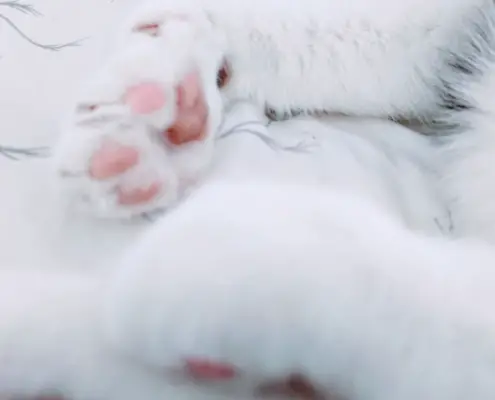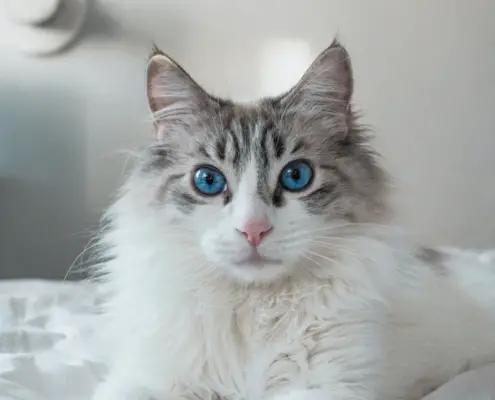Breed Name
British Longhair

The British Longhair cat breed is a perfect blend of beauty and grace. With their plush, flowing coats and gentle temperaments, these cats are a delight to have as companions. In this article, we will explore the history, physical characteristics, personality traits, grooming and care tips, health issues, and popular culture references of the British Longhair cat breed. Whether you are considering adopting a British Longhair or simply curious about these majestic felines, this article will provide you with all the information you need.
History and origins of the British Longhair
The British Longhair cat breed has a rich history that dates back several centuries. Its origins can be traced to the British Shorthair cat breed, which was initially developed in the United Kingdom in the late 19th century. Breeders sought to create a long-haired version of the British Shorthair, and thus the British Longhair was born.
The breed gained recognition in the 20th century and has since become a favorite among cat lovers worldwide. It is important to note that the long-haired gene in the British Longhair is recessive, meaning not all British Shorthairs carry the gene. Therefore, careful breeding and selection are required to maintain the breed’s distinct characteristics.
Physical characteristics and appearance of the British Longhair
The British Longhair is a medium to large-sized cat with a sturdy build. They have a round face, full cheeks, and large round eyes that give them a sweet and affectionate expression. One of the most striking features of the British Longhair is its luxurious coat, which is long, dense, and silky. The coat comes in various colors and patterns, including solid, tabby, tortoiseshell, and colorpoint.
The British Longhair’s coat requires regular grooming to prevent matting and keep it looking its best. Weekly brushing is recommended to remove loose hair and keep the coat clean and tangle-free. Additionally, occasional bathing may be necessary to maintain the coat’s shine and freshness. It is important to note that the British Longhair’s coat may vary in length and thickness depending on the individual cat, but in general, it is longer and fuller than that of the British Shorthair.
Personality traits and temperament of the British Longhair
The British Longhair is known for its gentle and easygoing nature. These cats are typically calm, affectionate, and well-mannered, making them great companions for individuals or families. They enjoy being in the company of their human counterparts and are known to be good with children and other pets.
While the British Longhair is generally laid-back, they still possess a playful side. They enjoy interactive toys and engaging in gentle play with their owners. Despite their love for playtime, they are not overly demanding and are content with a relaxed and peaceful environment. The British Longhair is also known for its intelligence and adaptability, making them easy to train and adjust to new surroundings.
Grooming and care tips for the British Longhair
The British Longhair’s luxurious coat requires regular grooming to keep it in top condition. As mentioned earlier, weekly brushing is recommended to remove loose hair and prevent matting. A stainless steel comb or a slicker brush is ideal for this purpose, as it helps to detangle the hair without causing discomfort to the cat. It is important to be gentle and patient during the grooming process, as the British Longhair may be sensitive to being handled roughly.
In addition to regular brushing, the British Longhair’s coat may benefit from occasional bathing. This helps to remove any dirt or debris that may have accumulated in the fur and keeps it looking clean and shiny. When bathing your British Longhair, use a cat-friendly shampoo and warm water. Be sure to rinse the coat thoroughly to remove all traces of shampoo.
Another important aspect of grooming for the British Longhair is maintaining good oral hygiene. Regular teeth brushing with a cat-specific toothbrush and toothpaste is recommended to prevent dental issues such as tartar buildup and gum disease.
Health issues and common concerns for the British Longhair
Like all cat breeds, the British Longhair is prone to certain health issues. While they generally enjoy good health, it is important to be aware of potential concerns and take preventive measures.
One common health issue in British Longhairs is obesity. Due to their laid-back nature, these cats can easily gain weight if not provided with a balanced diet and regular exercise. It is important to monitor their food intake and provide them with opportunities for play and exercise to prevent obesity-related health problems.
Another health concern for British Longhairs is polycystic kidney disease (PKD), a genetic disorder that affects the kidneys. Responsible breeders perform genetic testing to ensure that their breeding cats are free from PKD, reducing the risk of passing on the disease to future generations.
Regular veterinary check-ups and vaccinations are essential for maintaining the overall health and well-being of the British Longhair. It is important to establish a relationship with a trusted veterinarian who is familiar with the breed and can provide appropriate care and advice.
British Longhair cat breed in popular culture and media
The British Longhair cat breed has made appearances in popular culture and media, further establishing its charm and appeal. These majestic felines have captured the hearts of many cat enthusiasts and are often depicted in movies, TV shows, and advertisements.
In the 2001 film “Harry Potter and the Sorcerer’s Stone,” the character Mrs. Norris, Argus Filch’s loyal companion, is portrayed as a British Longhair. Mrs. Norris is known for her distinctive long, gray fur and watchful nature, adding an air of mystery and elegance to the film.
The British Longhair’s regal appearance and gentle demeanor have also made them a popular choice for advertising campaigns. Their presence in commercials and print ads further highlights their beauty and grace, making them a sought-after breed among cat lovers.
Finding and adopting a British Longhair cat
If you are considering adopting a British Longhair cat, there are several options available to you. One option is to contact reputable breeders who specialize in the British Longhair breed. A responsible breeder will ensure that their cats are healthy, well-socialized, and raised in a loving environment. They will also provide you with the necessary documentation, such as health certificates and pedigree papers.
Another option is to check local animal shelters and rescue organizations. While British Longhairs may be less common in shelters, it is not unheard of to find purebred cats in need of a loving home. Adoption fees are usually lower than purchasing from a breeder, and you will be giving a deserving cat a second chance at a happy life.
British Longhair cat breeders and associations
To ensure that you are adopting a British Longhair cat from a reputable source, it is essential to research and connect with established breeders and associations. The International Cat Association (TICA) and the Cat Fanciers’ Association (CFA) are two well-known organizations that provide information and resources for finding reputable breeders.
When contacting breeders, ask questions about their breeding practices, health testing, and the care they provide for their cats and kittens. A responsible breeder will be transparent and happy to answer any inquiries you may have. Additionally, they may have a waiting list for their kittens, so it is important to plan ahead and be patient during the adoption process.
Is the British Longhair the right cat breed for you?
In conclusion, the British Longhair cat breed is a perfect blend of beauty and grace. With their plush coats, gentle temperament, and regal appearance, they make wonderful companions for individuals or families. However, it is important to consider the grooming needs, potential health concerns, and the commitment required to care for a British Longhair before making the decision to adopt.
If you are looking for a cat that exudes elegance and charm, and you are willing to invest time and effort into their grooming and care, the British Longhair may be the perfect cat breed for you. With their affectionate nature and easygoing temperament, they are sure to bring joy and companionship to your home for many years to come.
If you are interested in adopting a British Longhair cat, be sure to research and connect with reputable breeders or rescue organizations in your area. Take the time to learn about the breed’s specific needs and prepare your home to welcome your new feline companion.
If you enjoyed my article, I would appreciate you sharing it with your network.

Sima Ndlebe
Sima writes for CatBuzz. He is interested in Cats, Health and Fitness, and Entrepreneurship.
Published: 10 October 2023



